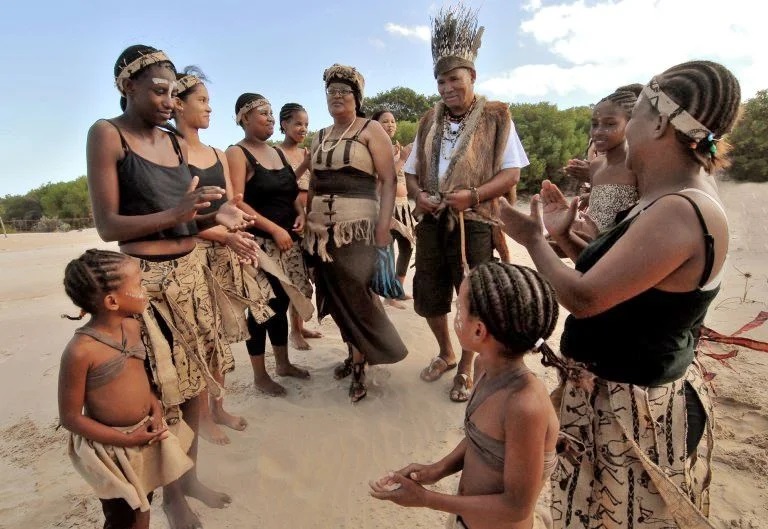
We’re sure many of us have seen videos of certain Africans speaking their native language with clicking sounds, sparking curiosity and amazement. These fascinating languages, known as the Khoisan languages, are spoken by the Khoikhoi and San (often referred to as “Bushmen”) communities in southern Africa. The languages are famous for their unique click consonants and hold a significant place in African linguistics. In this article, we’ll delve into the intriguing world of Khoisan languages, exploring their origins, unique features, and current status.
A Rich Linguistic Heritage
The Khoisan languages are a group of African languages known for their distinctive use of click consonants. These languages were once thought to belong to a single language family, but modern linguistic research has revealed that they actually consist of several different language families and language isolates. The term “Khoisan” is often used for convenience without implying that the languages are genealogically related.
Before the Bantu expansion across Africa, Khoisan languages, or languages like them, were likely spread throughout southern and eastern Africa. Today, they are mostly spoken in the Kalahari Desert, primarily in Namibia, Botswana, and parts of Tanzania.
Read: The Distinctive Hairstyles of Bini Chiefs: Uguakpata and Ogbon
The Click Sounds: A Linguistic Marvel
What truly makes Khoisan languages stand out are the click consonants. These sounds are produced by the tongue making two contact points in the mouth, creating a sharp clicking noise. Clicks are used as regular consonants in Khoisan languages, unlike in most other languages, where they are paralinguistic (used for non-verbal communication, such as expressing disapproval with a “tsk-tsk”).
These clicks are versatile and can be combined with other speech sounds, leading to some Khoisan languages having the highest number of consonants in the world. For example, the Juǀʼhoan language has 48 click consonants, and the ǃXóõ language has an even more complex sound system. It’s no wonder that these languages are considered linguistic treasures.
The Khoisan Language Families

Khoisan languages can be divided into several language families and isolates, each with its own unique characteristics. The main families include:
– Khoe-Kwadi: This family is the most numerous and diverse, with languages spoken in Namibia, Botswana, and South Africa. The Khoekhoe (Nama) language is the most widely spoken of these, with over 200,000 speakers.
– Tuu: This family includes languages like ǃXóõ, spoken in Botswana. These languages are known for their complexity and large consonant inventories.
– Kxʼa: The Juǀʼhoan language, spoken by the Juǀʼhoansi people of Namibia and Botswana, belongs to this family.
In addition to these families, two language isolates, Sandawe and Hadza, are spoken in Tanzania. Although these languages share some similarities with Khoisan languages, they are not considered part of the Khoisan family.
Endangered Languages
Unfortunately, most Khoisan languages are endangered, with several already extinct or on the brink of extinction. Due to social and economic pressures, Many Khoisan communities have shifted to speaking Bantu languages, such as Tswana or Zulu. Losing these languages would mean the disappearance of a unique and irreplaceable part of human linguistic heritage.
Efforts are being made to preserve and revitalize these languages. Projects like language documentation and community language programs aim to keep the languages alive for future generations. However, the challenges are immense, given the small number of speakers and the lack of written records for many of these languages.
Read: The Maasai: Africa’s Warrior Kings
The Cultural Significance of Khoisan Languages
Khoisan languages are not just a means of communication; they are deeply intertwined with the cultural identities of the Khoikhoi and San people. These languages carry with them the history, traditions, and knowledge of these ancient communities. For example, the names of animals, plants, and places in Khoisan languages often reflect the deep connection between the people and their environment.
Moreover, the use of clicks in these languages is believed to have ritual significance. In some Khoisan communities, certain clicks are reserved for use in religious or ceremonial contexts, highlighting the spiritual dimension of the language.
The Khoisan languages of South Africa are among the most unique and fascinating in the world. Their use of click consonants and their deep cultural significance make them a vital part of the global linguistic landscape. However, the threat of extinction looms large, making it crucial to preserve these languages for future generations.
Have you ever heard the clicking sounds of the Khoisan language? What are your thoughts on the importance of preserving endangered languages? Share your thoughts and join the conversation about safeguarding Africa’s linguistic heritage.
